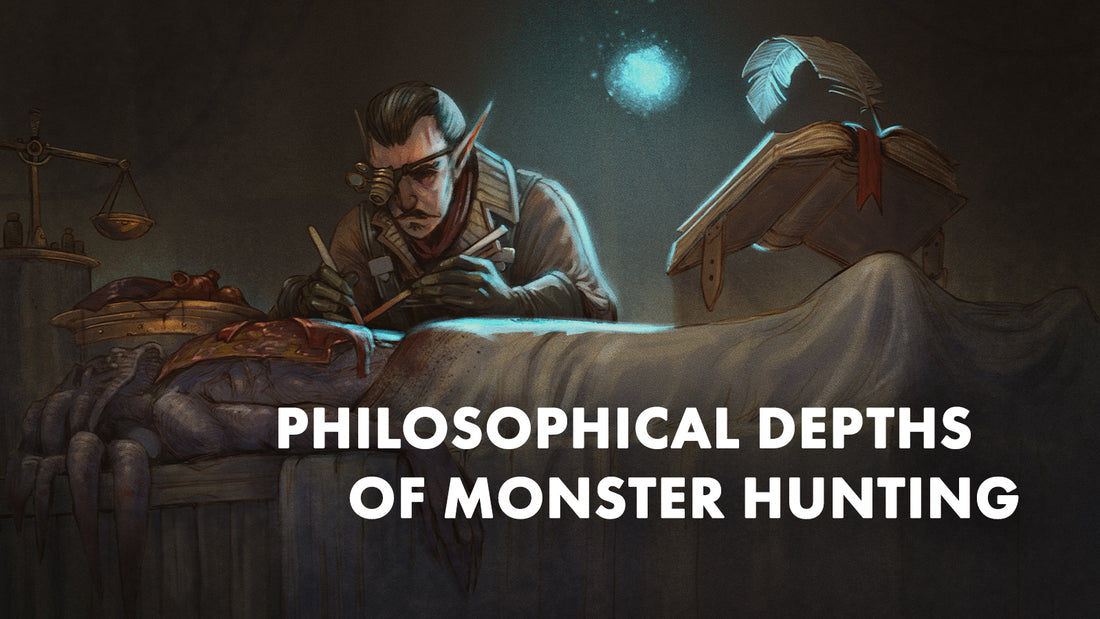Magic weaves through the air and creates the very fabric of the universe. In mystical realms of every possibility, mythical creatures roam freely. While sentient creatures plot, delve deep into the lore of the realms, try to dominate kingdoms, or protect the innocent, monsters wreak havoc. It is the very nature of the monster to hunt for survival. Some sentient beings thus feel compelled to hunt the hunter, to secure the survival of the others, sometimes even in the most gruesome of ways.
This chapter offers some philosophical insight into the necessary profession that is monster hunting, a metier that is both revered and feared. It is a guide into understanding the workings of a monster hunter’s mind, delving deep into the ethical considerations and the development of the right attitude for those daring enough to pursue the path of the monster hunter.
Ethical Considerations: To Hunt or Not to Hunt
The goal of this section is to ask philosophical questions on the ethics of killing monsters by presenting various perspectives. Here, monster hunters won’t find a didactic article that answers the related questions, but a guide that aids them in answering these questions for themselves.
The first question one must ask is “What is a monster?”; an inquiry that shapes any other question on the matter. Please note that though following approaches are commonly observed, the answer to this exceedingly personal question varies from person to person.
Defensive Approach
Those who advocate the defensive approach believe that creatures must not be killed unless it is a matter of life or death. They believe the only justification to kill a monster would be in defense of oneself or others.
The main ethical concern of this approach is to let creatures complete their cycles of existence, even if the creature does not display any traces of sentience or vitality.
Although the defensive approach may seem unsuitable for monster hunters to some, one sees that this isn’t necessarily the case when one imagines tangible examples. For instance, imagine a tiefling monster hunter who only kills those that pose a threat to their city. Such an existence is entirely possible.
Utilitarian Approach
People need to ensure their safety in order to survive, and they can hunt creatures and utilize their remains to do so. Wearing dragon scale armor, for example, offers better protection than clothing made of ordinary fabric. Similarly, using poison from a basilisk’s fangs can help townsfolk defend against goblin raids. The advocates of the utilitarian approach expand upon such examples to determine which creatures are deemed suitable for hunting and which are not. Generally speaking, they believe monster hunting is justified if it serves their society, and they determine what a monster is in accordance with this perspective.
A utilitarian adventurer in dire need of a fiend’s heart might see the fiend as a monster; however, another adventurer of a similar mindset may approach a fiend as an equal if they are not to benefit from the hunt. In short, a utilitarian hunter hunts as long as they need to hunt.
Sentiencentric Approach
According to those who follow the sentiencentric approach, if a creature is sentient, it shouldn’t be considered a monster. This approach focuses on the importance of sentience when deciding what to hunt. However, this perspective leads hunters to consider another question: What exactly is sentience?
Certain hunters argue that if a creature can talk and think, it’s considered sentient and therefore should not be hunted. On the other hand, there are those who suggest that the real question isn’t about the creature’s ability to reason or communicate. Instead, the focus should be on whether they can feel pain or distress.
The answers to these questions give rise to many others. To elaborate, plants are typically considered non-sentient. However, some adventurers can communicate with them using the speak with plants spell. Does this interaction make the plants sentient? The response lies in the spell’s details. Delving into the magical intricacies, it is seen that ordinary plants, lacking reasoning abilities, attain temporary sentience when affected by the speak with plants spell. Now, another question arises: is it acceptable to harm a plant while it is communicating with a magic user through spells? These are the queries that a sentiencentric hunter must grapple with.
All that being said, it is universally accepted among sentiencentric hunters that hunting beings like mindless undead such as skeletons, or constructs lacking reasoning abilities such as iron golems, is perfectly acceptable.
Divine Approach
Fiends could be the sworn enemies of a cleric of light, and dragons could be the cherished allies of a paladin whose deity manifests as a dragon. When determining whether a creature meets the criteria to be considered a monster and thus merits pursuit or not, hunters who are devoted to a particular deity usually follow their commandments and doctrines. In other words, those who adopt the divine perspective defer to their gods and goddesses to address this philosophical question on their behalf.
Even if a lich is sentient, and seemingly more intelligent than a cleric of life, it is a monster to those who take on the divine approach nevertheless. A succubus, in turn, can see a human fighter as a monster.
Hedonistic Approach
Hedonistic hunters find joy in the thrill of the hunt, the final scream before the prey takes its last breath, and the satisfaction of witnessing life leave the wounded creature. In the simplest of terms, they just want to hunt for the fun of it.
These hunters may hunt a tiefling for its skin, a goblin because they find it annoying, or an aboleth just because it’d make a cool decoration for their room. According to those who follow the hedonistic approach, anything and anyone can be seen as a monster; even sentient humanoid creatures.

